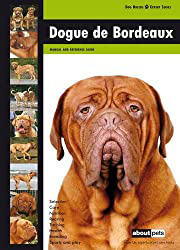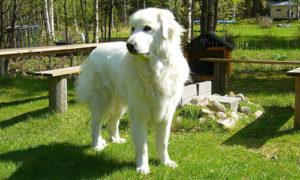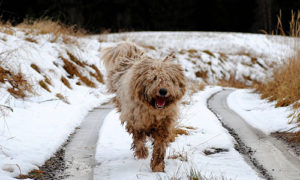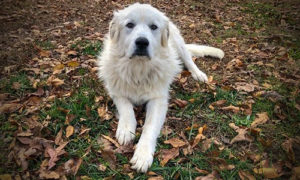
According to experts, the Dogue de Bordeaux or French Mastiff existed over 600 years ago, with some models dating back to ancient Rome. However, the exact origins are murky at best, but the first mention of the breed name was in 1863 at a canine exhibition, when breeders gave them the name of the French region in which created them.
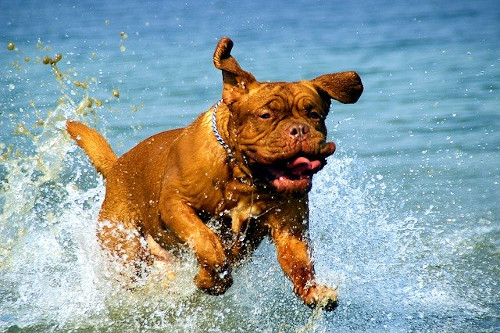
Throughout its history, Dogue owners used them for guarding and hunting. The French imported Dogue’s to America in 1890; unfortunately, the breed later became extremely rare in Europe and America. Thankfully, in the 1960s, French breeders began efforts to bring it back to prominence. The 1989 film Turner and Hooch introduced the Dogue de Bordeaux to the general public.
This dog is massive, sturdy with a dense bone structure and loose-fitting skin. It has a broad, sturdy back, a thick tail that reaches the hock and is carried low, and a muscular neck covered with ample skin. The head is large and full, with a short, powerful, undershot jaw; wide-set, oval eyes; small ears that lie close to the skull; and natural facial wrinkles. Dogue’s expression reflects courage, openness, and purpose.
Breed Facts
Activity level: Dogues need at least two twenty-minute walks each day. They do not tolerate heat and should never be exercised or left outdoors in hot weather. Lack of activity will lead to weight gain and potential bad behavior. The Bordeaux trains well in carting, obedience, conformation, weight pulling, water rescue, tracking, search and rescue, and therapy work.
- POPULARITY: Somewhat popular
- FAMILY: Mastiff
- AREA OF ORIGIN: France
- DATE OF ORIGIN: Middle ages
- ORIGINAL FUNCTION: Guardian, hunting, herding
- TODAY’S FUNCTION: Guardian
- OTHER NAME: French Mastiff, Bordeaux Mastiff, Bordeaux Bulldog
Dogue de Bordeaux Temperament

The Bordeaux is a sweet, even-tempered, devoted family companion. Still, owners must keep the breed’s heritage in mind—this is a guardian dog who is territorial, vigilant to changes in his environment, and reserved toward strangers. Dogues can be aggressive toward other dogs. They’re large and powerful but also quite sensitive. Early training, preferably as puppies, is essential, and a consistently positive approach will yield far better results than fruitless attempts to physically dominate a Dogue.
This dog is extremely devoted and loyal to its family. They tend to stay close to a chosen member of the family at all times. They’re vigilant watchdogs as well as dedicated protection dogs. Dogues like to satisfy their owners, but they’re not good with obedience unless they get something out of it. Bordeaux dogs are mostly mellow unless provoked. They tend to tolerate other pets.
Grooming
A weekly brushing will minimize shedding in this breed. A Dogue should be bathed about every two weeks and have his facial folds cleaned during baths. Grooming also includes regular nail trimming, regular ear cleaning, and cleaning of the eye area throughout each day.
- Coat: Short and fine
- Colors: Dark red to light fawn with a darker colored brown (mahogany)or black mask
Health
- MAJOR CONCERNS: CHD, elbow dysplasia
- MINOR CONCERNS: brachycephalic syndrome, ectropion, entropion
- OCCASIONALLY SEEN: aortic stenosis, DCM
- SUGGESTED TESTS: hip, elbow, eye, heart
- FRENCH MASTIFF LIFE EXPECTANCY: 5—8 YEARS
- WEIGHT: male: at least 110 pounds; female: at least 99 pounds
- HEIGHT: male: 23.5—27 inches; female: 23—26 inches
Dogue de Bordeaux breeders and Sale Advice
Owning a Dogue includes serious responsibilities because of the breed’s size and strength. Owners must have a serious commitment to training and ample time to develop to caring for a Dogue. Also, do not permit puppies to play-bite. Find a responsible breeder; this should be the only source from which you purchase a puppy.
- Parent club: Dogue de Bordeaux Society of America (www.ddbsa.org); founded in 1997
- Dogue de Bordeaux rescue, Inc. (www.ddbsarescue.org)
Dogue de Bordeaux Price
How much you pay for a Dogue will depend on situations such as the breeder’s litter size, popularity, puppy lineage, social training, breed lines, etc. Currently, the average price for a Dogue will run you about $1200. However, this price does not consider a dog with all of its papers, breeding rights, or show quality.

For example, Dogue de Bordeaux puppies without papers will cost less than a dog with all of its documents in order. However, I do not recommend purchasing a dog without the right paperwork. It isn’t wise and frankly just not smart business. That’s why we recommend buying dogs from reputable breeders. It will cost more in the short-term. However, it will save you a lot of headaches in the future.
Therefore, if you do it the right way, put aside at least $1200-$7500 and sometimes more if you’re looking for top tier breed lines and a superior pedigree. The Dogue de Bordeaux price you pay depends on if you’re looking for an average family pet or a show quality dog.

